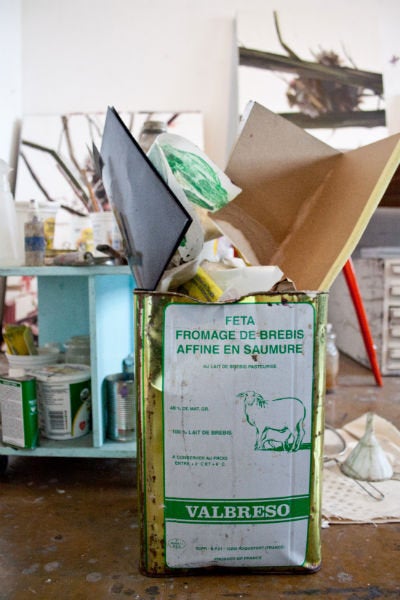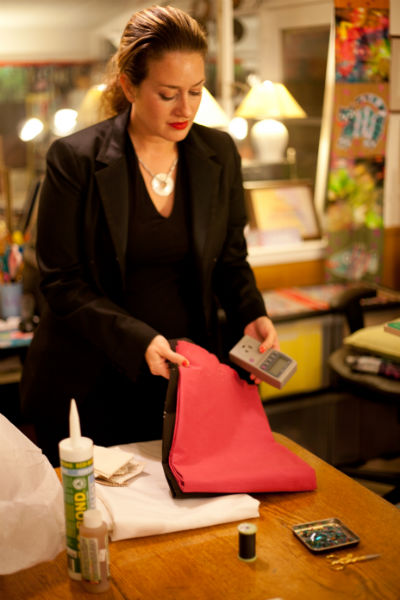
Creative industries have changed standards and best practices to adopt sustainable and environmental techniques in design and production. Architecture has adopted LEED Performance design into standard practice, and Industrial Design begins with thinking about the end of life of a product and how to leave the least amount of impact on the environment. Both of these industries fought for decades, since the 1970s, against changing habits, systems and academic content. Resistors during the transformation proclaimed they would all go out of business; it was impossible to get all stakeholders on board; and they didn't want to be creatively strangled.
This shared history of transforming creative industry leads us to a problem we are facing within the Art world. Can artists change the way they create work to make a healthier planet? Personally, I believe so, however, with the inclusion of all key players from the art world, including: art institutions, art media, academia, retailer/manufacturers, collectors and artists. Art seeds culture and influences public behavior. If artists can change their standard of practice then the rest of the world will follow.
 Art Inspector assessing quilters studio. Photo by Wendy Crockett.
Art Inspector assessing quilters studio. Photo by Wendy Crockett.
How is this transformation possible? Incorporating a triangle approach to such transformation is The Art Inspector, a social practice artwork I founded during my candidacy for a Masters in Fine Arts at San Jose State University, uses a Healthy Art Program (education), Legislative Reform (advocacy) and Third Party Inspections (studio assessments). This project started a few years ago when I noticed fellow studio mates as well as the art school itself seemingly unconsciously teaching and using harmful applications and techniques, disposing of waste, and ineffectively ventilating rooms. I noticed piles of plastic thrown into dumpsters, studio lights left on for what seemed 24 hours at a time, and complete negligence when using harsh chemicals. In my studio, a rusty cabinet labeled "Store Harsh Chemicals Here" written upon faded masking tape hosted a dusty plastic binder labeled MSDS Sheets. Taking a closer look, I realized no one had taught me what Material Safety Data Sheets meant and how they might apply to what I do. I asked around to other artists what they might know about these sheets and what they thought about what they were using and how they were disposing of extra material. Many artists noted that they knew someone, or had experienced themselves, long term health problems from misuse of chemicals in the creation of artwork. Most artists intuitively believed that there was a better way to develop their work and acknowledge the harm of some of the materials, but did not know what to do about it or did not see change as a high priority.
Inspired by artworks using methods of Intervention Art which take on the roles and aesthetics of corporations and disrupt systems in unexpected ways, such as the Yes Men and Luther Thie, I decided to become an Art Inspector. Within construction and manufacturing, unaffiliated auditors determine if a building or product can be certified as sustainable. If deemed so, doors open for prospective buyers and subsidies. I wanted to take this method to the Art World.
But how does a third party inspection work? There are at least two inspections to take place. The initial inspection starts with an intake form that asks questions to each artist about their studio environment, materials they are using, and the type of machines or equipment that use power. During this process a series of tests are conducted using similar equipment used for energy audits in residential homes. The Art Inspector tests power outlets, lighting and occupancy, ventilation and Volatile Organic Compounds. Once the inspection process is finished The Art Inspector will write up a report based on the data collected and make suggestions for alternatives and improvements to artists studios and the working process. If the artist makes the recommended modifications, The Art Inspector will return for a re-inspection and award a Healthy Art Certification if the artist passes.
 Paint waste from inspection of painter's studio. Photo by Wendy Crockett.
Paint waste from inspection of painter's studio. Photo by Wendy Crockett.
Artists who fail inspection or those who are interested in diving deeper into changing their habits can join the Healthy Art Program. Various workshops ranging from green materials, sustainable wood products, energy efficiency, lighting and safety are available to artists at varying partner institutions. If the artists are supplied with resources and knowledge, they will be empowered to change. The final part of The Art Inspector is to advocate for change in policy and curriculum on both an institutional and government level. Working with academic and museum institutions to adopt new values and requirements for artworks to be created sustainably will create a shift in the resources for production of art. If a major contemporary art museum such as the San Francisco Museum of Modern Art sets a standard for new works to be exhibited using a significant amount of low impact materials and works with third party agents such as The Art Inspector, then other practitioners will follow. With this same concept, Public Art Programs can adopt LEED standards into creation of artworks in the public realm.
Even today these concepts of change in the Art World are seen as radical and frightening to some. However, many artists are willing to do what they do best, experiment with new ideas. With the vision of The Art Inspector, we will open up the avenues to sustainable living, healthy living, and simultaneously, changing the way we make art.